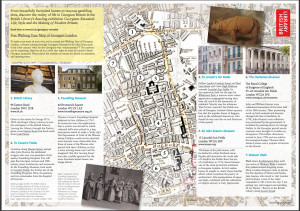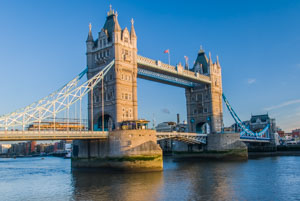
The early years of the 18th century saw the birth of newspapers in London. The early papers, the most notable of which was Richard Addison's Spectator, catered to the demands of an increasingly literate population. Many of the newspapers that followed Addison put up shop along Fleet Street.
The Georgian period in London coincided very neatly with the Palladian Revival in architecture and art. Lord Burlington, in his 1715 design of Burlington House in Piccadilly, played a major role in popularizing this classical style which became the norm for much of the century. A few years later, in 1725, Lord Burlington was at it again, with his remodeling of Chiswick House, then a country retreat but now part of the greater London sprawl.
At the same time, Grosvenor Square was laid out in Mayfair, part of the Grosvenor family's development of that aristocratic district. More London squares followed, notably at Berkeley Square (design by William Kent). Kent was also responsible for building the Treasury Building (1733), and the Horse Guards (1745).
Theatre, which had been so popular under the Stuart Restoration, became a little too vociferous for the taste of the city authorities. In 1737 a series of satires staged at the Theatre Royal Haymarket so infuriated them that the Lord Chamberlain was given the power of censorship over all public theatre performances. This power was not revoked until 1968.
For some six hundred years the only bridge across the Thames in London was London Bridge, of nursery rhyme fame. However, the growing city demanded more ease of movement, so the shops and houses on London Bridge were pulled down, and large sections of the old city walls destroyed. In 1750 a second stone bridge was added, Westminster Bridge.
In 1759 the British Museum opened its doors for the first time. The museum was based on a collection of "curiosities" collected by the packrat nobleman, Sir Hans Sloane. When Sloane died his collection, really a jumble of oddments that happened to catch Sloane's fancy, was acquired by the government and put on display to the public.
If the early Georgian period was influenced by Lord Burlington, the latter was the domain of Robert Adam and his neo-classical imitators. Adam was responsible for a spate of influential house designs around London, including Syon House (1761), Osterley Park, and Kenwood House.
A year after Adam's work at Syon, King George III and Queen Charlotte moved into Buckingham House (later to become Buckingham Palace). St. James Palace remained the official royal residence.
One of the biggest social revolutions in Georgian London was a quiet one. It was the popularity of coffee houses as a forum for business, entertainment, and social activity. The London coffee houses were immensely popular, and certain houses became associated with different political viewpoints or kinds of commercial activity. It was in one of these coffee houses, New Jonathan's, that merchant venturers (read entrepreneurs) gathered, and formed what was to become the London Stock Exchange.
Lest you think that religious strife ended with the demise of extreme Protestantism after the English Civil War, 1780 saw the outbreak of what we now call the Gordon Riots. The riots began as a march through the streets of London to protest the Catholic Relief Act, which granted basic rights to Catholics.
The marchers, under the vociferous leadership of Lord George Gordon, let their religious prejudice boil over into a week of looting and murder. For that week Londoners lived their own version of the "Reign of Terror" which later gripped Paris. The Gordon Riots terrified the authorities and brought repressive measures against any form of protest or reform-minded writing.
On a lighter note, Georgian London saw a new form of entertainment, the pleasure garden, become popular. These pleasure gardens, notably at Ranelagh and Vauxhall, were like outdoor amusement parks, complete with musicians and fireworks.
What to See:
Burlington House
Chiswick House
Horse Guards
Westminster Bridge
British Museum
Syon House
Osterley Park
Kenwood House
Buckingham Palace



<< Back Stuart London | Victorian London Next >>
London History
Roman | Anglo-Saxon | Medieval | Tudor | Stuart | Georgian | Victorian London | 20th century London
English History
Also see "English History" and our award-winning "English Culture" section.


